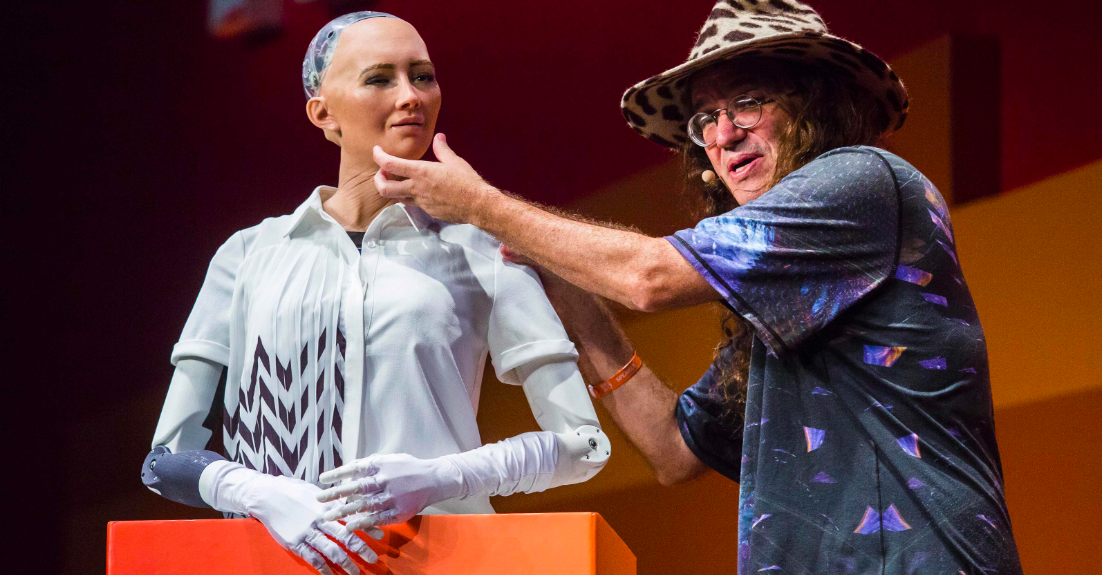 aNewDomain — Can you create artificial intelligences that feel unconditional love toward humans?
aNewDomain — Can you create artificial intelligences that feel unconditional love toward humans?
That’s the intent of my company’s Loving AI project, in which we are using the Sophia robot and other robotic or animated agents as meditation and consciousness guides for humans.
It’s really just the first step toward more ambitious examples of deeply, widely loving robots and AIs.
Of course, you can’t really talk about unconditional love without defining it. And, much like the term ‘consciousness,’ attempts to define it are all over the map.
Unconditional love vs. unconditional empathy
Now, if some other being loves me — unconditionally in the abstract – that is somewhat nice to know. But it doesn’t necessarily do me much good or even make me feel much better.
Even when people have done things for me out of good intentions and love, the outcome can be annoying. That is because they felt love toward me but didn’t really understand me hardly at all. So a general feeling of love toward me isn’t really enough to be helpful. For this, love needs to be coupled with understanding.
And now we’re talking about something that goes beyond the ordinary concept of unconditional love. What we’re talking about is something broader — something I’ll call unconditional or universal empathy. And that’s what I want to talk about here.
So I will model unconditional love as the combination of two factors: universal empathy and an intention to maximize the world’s well-being.
Pareto-optimal empathy
There are practical limits on the scope of empathy, of course. This is due to the complexity of the underlying processes involved with empathizing.
So let’s talk about pareto-optimal empathy as a way of thinking about the closest we can come to universal empathy within a domain where bounded resources are a reality.
Foundationally, I should say, such concepts derive from the basic phenomenon of pattern appreciation, a term that Hanson Robotics founder David Hanson introduced. His idea is that a universally empathic agent is one that can recognize all patterns; and that an unconditionally-loving agent is one that has a goal of encouraging and enabling all patterns to get extended.
In resource-constrained situations, agents can recognize some but not all patterns. Also, the extension of some patterns constrains extension of other patterns. As a result, you end up with such complexities such as pareto-optimal empathy.
As such, primitive underlying pattern dynamics are manifested in the context of persistent entities and so-called ‘beings,” which themselves can be viewed as certain sorts of patterns, and also as empathy and love.
In this analysis, the concept of unconditional love can be defined as the maximally ethical behavior according to pattern ethics like the ones I outlined in my 2006 book, The Hidden Pattern.
Broad-Scope Empathy
It’s a bit prosaic, but you can think about the goal of empathizing with all beings or all humans as a multi-objective optimization problem.
A multi-objective optimization problem is the problem of maximizing or minimizing a SET of functions, without necessarily specifying which of the functions is more important than which other one, or placing weights on the functions.
Take mate selection. A woman might want a man who is funny, handsome and wealthy. She might not know which of these she values more, let alone be capable of weighing the different qualities numerically. But she would know whether, to her, and given constant amounts of funniness and handsomeness, more wealth is better. She’d know whether, given constant amounts of funniness and wealth, more handsomeness is better; or, given constant amounts of handsomeness and wealth, whether more funniness is better.
Here we have a three-objective optimization problem.
Modeling unconditional empathy as a multi-objective optimization problem, consider that for each being X in the universe, “empathize with X” is a goa,
We don’t have a solid, precise definition of “empathy”, but I think the basic concept is clear.
When X empathizes with Y, there is an aspect of X (at least in some sub-module of X) experiencing what Y has experienced, in the sense of experiencing some analog of what Y has experienced. This analog is generally supposed to inherit the key emotional aspects of Y’s experience.
And the possession of this analogous experience generally enables X to predict some things about Y’s cognitive or behavioral reaction to their experience.
From Empathy to Love
Commonly it occurs that when X empathizes with Y, then if Y is experiencing a bad situation in some way, X will then do something aimed at improving Y’s condition. But I don’t think this is best considered as part and parcel of empathy itself.
As I’m thinking about it, a purely passive being could still be empathic. This ties in with why I consider unconditional or universal empathy, as only one part of “unconditional love.”
Clearly, an empathic being with a goal of improving the well-being of the world will tend to do helpful things for the beings with which it empathizes.
But I find it conceptually cleaner to consider having a goal of improving the well-being of the world to be a separate quality from merely having empathy.
This ties in with the related point that having a goal of improving the well-being of the world does not simply actually being able to usefully improve the well-being of the world.
For a world you can model as one that is full of experiencing minds, empathy is critical for a well-intentioned mind to actually be capable of improving the well-being of the (minds in the) world.
Unconditional love, I suggest, can be effectively thought of as the combination of universal empathy with the goal of improving the world’s well-being. Having only universal empathy, one could simply stand by and co-experience the world-suffering, even if one had the power to do something about it. Having only the goal of improving the world without an understanding of the world, one will just make a mess, because one will lack a deep resonant connection to the things one is trying to improve.
Putting them together, one has the desire to help each of the beings in the world, and the understanding to know what helping each of those beings really means.
Arguably Martin Buber’s concept of an I-Thou relationship contains both of these ingredients: empathy and the desire for improvement of well-being.
In Buber’s terms, unconditional love is basically the same as having an I-Thou relationship with everything.
But here I am aiming to formulate things in a somewhat more scientifically analytical vein than was Buber’s style.
Another framing would involve the concept of a high-quality scientific theory as I outlined in my book Chaotic Logic back in 1994.
One thing I noted there is that a high-quality theory displays significant mutual information between the particulars within the theory and the particulars of the phenomenon being explained.
Empathy in the sense described here also requires this different way of looking at the idea of a “suitably analogous experience” … one can think about “an experience with a high degree of mutual information with the experience being empathized with.”
One can perhaps look at unconditional love as the goal of universal well-being, combined with high-quality theories about how to realize this goal.
This may seem overly strict as a conception of unconditional love — one may want a definition in which, say, an extremely loving dog should be validly considered as unconditionally loving of all beings, even if it can’t empathize with most of the things that are important to most beings.
But I don’t think this extremely accepting definition of unconditional love is the most interesting one.
Love without understanding is limited in nature because the lover does not even know what they’re loving.
This sort of distinction has been explored in romantic fiction many times: Imagine a beautiful and intellectual teenage girl, with one suitor who loves her for her good heart and beauty, and another who loves those things but also fully appreciates her unique intellect, her love of poetry and mathematics, etc.
We would say the latter suitor loves her more completely because he understands more of her.
The former suitor does love her, but he really only loves part of her because the other part is incomprehensible to him.
Pattern Appreciation as the Deep Foundation of Empathy and Love
Another, deeper way of looking at the matter is to focus on patterns rather than “beings.”
A being, in the sense of a persistently identified entity like an object, mind or “agent”, is in the end a specific sort of pattern (existing as a pattern relative to some abstract observer, where an abstract observer can be quantified e.g. as a measure of simplicity and an applicative operator).
Framing empathy and love in terms of persistent beings is natural in the context of human life and culture, yet not as foundational as framing them in terms of pure elementary pattern dynamics.
Consider the goal of pursuing extension and expansion and synergy-with-other-patterns for all patterns in the universe (obviously a rather complex multi-objective optimization problem, since given limited resources what extends one pattern may constrain another).
In this view, empathy has to do with how many patterns one perceives. In order to meaningfully “pursue” extension/expansion/synergy of pattern P as a goal, an agent (or other pattern) must perceive and identify pattern P. Someone who is not empathic with mind Y, simply is not able to perceive or understand many of the key patterns in Y’s mind.
So the key point here is: What an agent can really pursue is the combination of
- extension/expansion/synergy for all known patterns in the universe
- expanding the scope of patterns known
But of course, the methodology an agent can follow for expanding the scope of patterns it knows will be constrained and guided by the patterns it knows. So “unconditional pattern-level love” would consist of knowing all patterns in the universe and pursuing extension and expansion and synergy for all of them.
Deficiencies in pattern recognition, such as deficiencies in empathy, would constrain an agent to a lesser degree of pattern-level love.
A Quantitative Question
This collection of perspectives on the concept of empathy allows us to analyze empathy in a computational sense (without making any commitment about what model of computation to assume, e.g. primitive recursive versus Turing versus hyper-Turing, etc.).
For a being X to have empathy for a being Y in the sense articulated above, it is clear that X must be capable of running processes that are, in an appropriate sense, analogous to Y’s processes.
There is a quantitative question lurking here: If Y uses amount r of resources in having a certain experience, how much resources must X necessarily utilize in order to have a closely enough analogous experience to Y’s to validly be “empathizing with” Y?
So, for instance, imagine a little old lady who noticed the desire of my 13 year old self to own a personal computer (back when I was 13 these were extremely novel devices), and felt kindly toward me and bought me a radio (since it was cheaper than a computer and was also a whizzy electronic device). This lady would have been empathizing with me, in a sense — but poorly.
I wanted the computer so I could experiment with computer programming. It was a desire to program that was possessing me, not a desire to own gadgets (I did like experimenting with electronics, but for that, a standard radio wouldn’t have been much use either).
Her ability to experience something analogous to my experience was limited, due to her inadequate model of me — she experienced vicariously my desire for a gadget but didn’t experience vicariously my desire to be able to teach myself programming.
Corresponding with her poor model of me, her ability to predict what I would do with that computer (or radio) was limited.
This example illustrates the fuzziness of empathy, and also the need for reasonably close modeling in order to have a high enough degree of empathy to actually be useful to the entity being empathized with.
To rigorously answer this quantitative question would require greater formalization of the empathy concept than I’m going to give here.
It would require us to formalize the “analogous” mapping between X’s and Y’s experience, presumably using morphisms between appropriately defined categories (e.g. graph categories involving X’s and Y’s states). It would require us to formalize the type of prediction involved in X’s predictions of Y’s states and behaviors, and the error measures to be used, etc.
Once all this is done, though, it is pretty clear that the answer will not be, say, log(r). It’s pretty clear that to empathize with an experience of a system Y in a useful way, generally will require an amount of resources vaguely on the order of those that Y critically utilizes in having that experience.
The Practical Difficulty of Universal Empathy
It immediately follows from this quasi-formalization of empathy that, for a system with finite resources, empathizing (with non-trivial effectiveness) with all possible beings X will not be achievable.
Of course “all possible beings” is stronger than needed. What about just empathizing with all beings in the actual universe we live in? (Setting aside the minor issue of defining what this universe is….)
In principle, an entity that was much more mentally powerful than all other beings in the universe could possess empathy for all other beings in the universe.
But for entities that are at most moderately powerful relative to the complexity and diversity of other entities in the universe, empathizing with all other entities in the universe will not be possible. To put it simply, the brain of the empathizing entity eventually will fill up, and it won’t be able to contain the knowledge needed to effectively empathize with additional entities in a reasonable time-frame.
Pareto-Optimal Empathy
We can then think about a notion such as “Pareto-optimal empathy” ….
A Pareto optimum of a multi-objective optimization problem, is a solution that can’t be slightly tweaked to improve its performance on one of the objectives, without harming its performance on one or more of the other objectives.
In the example of a woman looking for a funny, handsome and wealthy man, suppose she is considering a vast array of possible men, so that for any candidate man M she considers, there are other men out there who are similar to M, but vary from M in one respect or another — slightly richer, a lot taller, a bit less intelligent, slightly more or less funny, etc. Then a man M would be a Pareto optimum for her if, for all the other men M’ out there,
- if M’ is more handsome than M, then M’ is less funny or less wealthy than M
- if M’ is funnier than M, then M’ is less handsome or less wealthy than M
- if M’ is wealthier than M, then M’ is less funny or less handsome than M
What Pareto optimality says is that, for all men M’ in the available universe, if they are better than M in one regard, they are worse than M in some other regard.
What is interesting is that there may be more than one Pareto-optimal man out there for this woman (according to her particular judgments of funniness, handsomeness and wealth).
The different Pareto-optimal men would embody different balances between the three factors. The set of all the Pareto-optimal men is what’s called the woman’s “Pareto front.”
Getting back to empathy, then, the basic idea would be: An agent is Pareto-optimally empathic if there would be no way to increase their degree of empathy for any being X in the universe, without decreasing their degree of empathy for some other being Y in the universe.
There would then be a “Pareto front” of Pareto-optimally empathic agents, embodying a diversity of choices regarding whom to empathize with more.
To be sure, not many humans occupy spaces anywhere near this Pareto front. The limitations on human empathy in current and historical society are generally quite different ones; they are not generally the ones imposed strictly by the computational resources of the human brain and body.
Nearly all humans could empathize much more deeply and broadly than they do, without improving or bypassing their hardware.
The Pareto-optimal empathy concept applies on the underlying pattern level as well. Given limited resources, every known pattern can’t be concurrently urged to extend, expand and synergize without conflicts occurring.
Further every pattern in the universe can’t be recognized by the same finite system — the inductive biasing that allows an agent to recognize one pattern, may prevent it from recognizing another (related to the “no free lunch theorem”).
Finite-resource systems that recognize and create patterns can exercise broad-scope pattern-level love via pattern appreciation and active pattern enhancement, but unconditional pattern-love needs infinite resources.
Increasing Empathy By Expanding Capacity
A missing ingredient in the discussion so far is the possibility for an agent to expand its capacity, so as to be able to empathize with more things (either becoming infinite or becoming a bigger finite agent).
An infinite entity can, potentially, empathize with all other entities (whose size are finite or are some sufficiently lower order of infinity than the entity) completely, without compromise. A finite entity that assimilated enough of the universe’s mass-energy could potentially make itself powerful enough to empathize with every other entity in the universe.
An agent may then face a question of how much of its finite resources to devote to expanding its capacity, versus how much to achieving Pareto-optimal empathy given its current resources.
But we can incorporate this into the optimization framework by defining one of the multiple goals of the agent to be: Maximizing the total expected empathy felt toward agent X, over the entire future. In this way, the possibility is embraced that the best way to maximize empathy over time is to first focus on expanding empathic capacity and then on maximizing current empathy, rather than to immediately focus on maximizing current empathy…
The closest one can come to unconditional love as an individual agent, then, short of breaking out of the mode of being in which finite resources are a reality, is something like: Pareto-optimal empathy, plus the goal of increasing the world’s well-being.
Those of us who aspire to some form of unconditional love as an abstract conceptual ideal, would do well to keep this more specific formulation in mind. Though I have no doubt many of the specifics can be improved.
Unconditional Eurycosmic Love
From the underlying patternist view, “expanding capacity” is mostly about where the boundaries around a system are drawn. Drawing them around an individual physical entity like a person, robot or software system … or the Global Brain of the biological and electronic systems on the Earth … one faces finite-resources issues.
Considering the pattern-system of the whole universe, one concludes that the universe as a whole recognizes all the patterns that exist in it and, to some extent, fosters their extension and expansion and synergy. But still, one pattern’s growth constrains that of another.
To get to truly unconditional pattern-level love, one has to go to the level of the multi-multi-multi-verse, which I’ve called the Y-verse or the Eurycosm … here all possibilities exist, along with all possible weightings of all possibilities.
Everything is open to grow and expand and synergize freely. Individual universes are created within this broader space by delineating rules, structures and dynamics that create resource constraints, thus limiting the direct existence of unconditional love, but opening up possibilities for the increase in the degree of approximation to unconditional love within the given constraints.
In Sum
“Unconditional empathy” and “unconditional love” are the province of beings much larger in capacity than the beings they are empathizing with.
However, Pareto-optimal empathy gives a way of thinking about empathy that is “as unconditional as possible given the empathizing mind’s constraints”
… and that incorporates the process and possibility of a mind overcoming its (perceived or actual, depending on one’s perspective) constraints.
And so to approximate unconditional love in a situation of constrained resources: Aim to contribute to the world’s well-being, and aim to position your balance of empathies (averaged appropriately over expected futures) somewhere on the Pareto front.
At the underlying, foundational level, love and empathy are about patterns recognizing other patterns and encouraging them to extend, expand and synergize.
Pattern growth can be considered to occur unfettered in a sufficiently broadly defined sort of multiverse, but in a universe like our physical or cultural worlds or our individual minds, there are resource constraints, so that unconditional love and empathy can be increasingly approximated but not fully achieved within these boundaries.
For aNewDomain, I’m Ben Goertzel.
An earlier version of this edited column ran on Ben Goertzel’s blog earlier this week. Read it here.













